Overview
In previous literature, Cambridge Centre for Alternative Finance (CCAF) postulated that the major energy source used by the Bitcoin network was coal. In my Feb 2023 article in Bitcoin magazine, I suggested that this conclusion would need to be revisited as it was based on a dataset that did not include off-grid mining (as acknowledged on their website).
This report is that revisitation. When off-grid mining is factored in, we get a full picture of the Bitcoin network. The major energy source is hydro (23% of all Bitcoin mining).
Why Hydro?
Ongrid, 15.8% of power is hydro (source: Our World in Data), however more than half of all sustainable off-grid mining is hydro-powered.
Sustainable mining companies such as OceanFalls, Blockfusion, Hive, Iris, Sato, Terawulf, Statar/Lake Parime, Gridshare and HPG are examples of companies that are either 100% powered by hydro or majority-hydro powered.

The next highest sustainable energy source is Wind, now representing almost 14% of all bitcoin mining power. Companies such as Marathon, with 14 EH of hashrate, the heavy component of which is behind-the-meter wind farms, contribute to this strong showing.
The high proportion of wind energy on the ERCOT grid, where almost 1/4 of the Bitcoin mining network are now located, is another factor for the strong showing from wind (see ERCOT 2023 Generating Capacity below).

Coal
Bitcoin, like eVs, is a fully electrified technology with zero direct emissions. In each case their (scope2) emissions arise from using electricity which is generated using in part fossil fuels. Where Bitcoin mining is different from eVs is that Bitcoin mining is not 100% tethered to the grid. As a consequence Bitcoin’s energy source and emissions may vary from the grid-mix of that nation.
A 100% grid-tethered e-technology such as eVs will be bound by the sustainability of the grid it happens to be on. Globally, assuming that eVs are proportionally distributed around the world, we would expect eVs to mirror global grid-mix and therefore to have coal as their major energy source (36.7%), followed by gas (23.5%).
Compared to eVs, Bitcoin mining uses a similar proportion of gas (21.14%) but a significantly lower use of coal as an energy source (22.92%): 38% less than eVs.

This pie graph is dynamic and reflects the network as of 30 March 2023. Changes in hashrate, power consumption, and mining activity will impact overall percentages.
Future forecasts
The BEEST model suggests that the sustainable composition of the Bitcoin network is currently increasing at 6.2% per year. if sustainable energy growth continues to trend upwards, then this is likely to cause the relative percentages of coal, gas and other fossil fuel sources to decline.
Methodology
1a. Use the CCAF model to identify the ongrid portion
1b. Use Our World In Data statistics to calculate breakdown of ongrid portion by energy source.
2a. Use BEEST model to assess exclusions not factored into the CCAF model (ie: ERCOT data and offgrid mining data)
2b. For each of the known sustainable-energy based mining companies, assess sustainable energy breakdown (bottom up calculations, aggregating data miner-by-miner)
2c, Report 2b for fossil-fuel based offgrid mining activity
3a. Add (sustainable ongrid) + (sustainable offgrid + ERCOT) data for each sustainable fuel type
3b. Add (fossil fuel ongrid) + (fossil fuel offgrid + ERCOT) data for each fossil fuel type
*we use global ongrid data from Our World in Data, which calculates sustainable energy as making up 36.7% of all electricity usage. CCAF however calculate that ongrid Bitcoin mining uses a slightly higher 37.6% sustainable energy. This 0.9% difference causes a slight underestimation in the level of each sustainable energy type. We are working to incorporate this factor into future versions of the model.
